#Neem Skin Benefits
Explore tagged Tumblr posts
Text
Neem Medicinal Herb | Benefits of Neem
Neem Medicinal Herb Neem Medicinal Herb In the world of Ayurveda, neem is a popular medicinal herb that’s been part of traditional remedies that date back almost 5000 years. Neem is also known as Azadirachta Indica in English or ‘Neemba’ in Sanskrit, the neem tree is a really good example of how nature holds both the problem and the cure. It’s home to more than 130 different biologically…
#Ayurveda Lifestyle#Benefits of Neem#Medicinal Uses of Neem#Neem Hair Care#Neem Leaves Uses#Neem Medicinal Herb#Neem Skin Benefits
0 notes
Text
When it comes to skincare, what you put on your skin matters as much as what you put into your body. Organic bar soaps have been making waves in the skincare industry, especially among those who prioritize natural and sustainable products. But not all organic bar soaps are created equal. Some are packed with ingredients that do wonders for your skin, while others may fall short. So, how do you choose the best organic bar soap? By knowing which ingredients to look for. In this blog, we’ll break down the top 5 ingredients that should be on your radar when shopping for organic bar soaps.
#gram flour soap#neem soap#sandalwood soap#multani mitti soap#mysore sandal soap benefits#yardley london soap#body skin whitening soap#handmade soap#lifebuoy soap barcode#soap making kits#ayurvedic soap#liquid soap dispenser#wall mounted soap dispenser#herbal soap#indian soap#kuppaimeni soap#dog soap#face ubtan soap#godrej no 1 soap tfm#maxisoft soap#nature power papaya soap#skin care soap#soap for oily skin#soap molds#donkey milk soap
0 notes
Text
Neem powder, it is made from the neem tree, gives a number of benefits for the body and mind. It is a popular natural medicine for itchy, acne, and acne because of its potent antimicrobial, antifungal, and antibacterial qualities. Neem powder also helps with breath and prevents gum disease, Its strong antibacterial and antifungal qualities make it an excellent natural dental remedy. It lessens plaque, fights bad breath, and prevents cavities by eliminating harmful germs in the mouth. Neem powder also helps to prevent gum diseases like gingivitis, lessen gum infection, and promote overall good oral hygiene. The regular use of neem powder in oral hygiene regimens, not only save us from harmful chemicals like some commercial market products, but it can also strengthen teeth, encourage healthier gums, and enhance odor. Additionally, it promotes the immune system, the process of detoxification and treats dandruff and boosting hair growth to maintain the health of your scalp and hair. Please visit our website or amazon page to explore our organic supplements products.
#neem#organic#haircare#pure#skin care#detoxification#anti bacterial#natural healing#skin glow#traditional medicine#herbal remedies#acne treatment#healthy skin#immune support#digestive health#natural detox#blood purification#herbal skin care#neem powder#neem powder benefits#natural antiseptic#neem benefits#organic neem#neem powder uses#green health
1 note
·
View note
Text
SSCPL Herbals Oil Control Neem Turmeric Facewash - Natural Acne Control - Buy Now!

SSCPL Herbals Oil Control Neem Turmeric Facewash. Control acne and improve skin health with natural antibacterial and antifungal properties. Moisturizes and protects skin. Shop now for clear, healthy skin!
#SSCPL Herbals#Oil Control Neem Turmeric Facewash#acne control#antibacterial facewash#antifungal facewash#neem oil benefits#skin health#moisturizing facewash#antioxidant facewash#Oil Control Facewash
1 note
·
View note
Text
Neem For Glowing & Clear Skin, Popular Benefit!

Neem is a tropical tree native to India. It is a powerful herb to use in numerous cosmetic uses. The extract form of neem is famous like neem juice, neem oil, etc for skin care health. The dark appearance and strong smell may not invite you to use the neem for the skin, but you would be surprised to know how much cosmetic and skincare products induce neem in their ingredients. Neem contains a high amount of omega 3, 6 and 9 fatty acids. The neem juice or oil has become a fundamental product for skincare, and especially for treating acne, thanks to its antibacterial properties. Neem works internally as well as externally to offer glowing and clear skin to the body.
Drinking neem juice purifies the body internally as well as increases blood circulation in the body. A healthy and clean flow of blood gives a good result on the skin cells. Applying neem oil can cure the skin from the outside. It keeps the skin safe and prevents the skin layer. It is important to keep in mind that if you are using strong neem juice or neem oil, it is advisable to always dilute them. You can dilute neem juice with water and dilute neem oil with other natural or essential oils, or by adding a few drops of neem to our usual cream.
Neem benefits the skin
There are many medical properties in the neem leaves, neem seeds, neem stem, etc. Below are the following benefits of using neem juice or neem oil or etc.
For acne and pimples: Many products used to treat acne are too aggressive with the skin sometimes. It also provides the hydration of the skin. In such cases, neem products like oil are the perfect solution. Neem has antiseptic properties that are ideal to fight against annoying pimples. The neem product is capable of regulating excess oil on the skin and keeping it hydrating throughout the day. Neem also has antimicrobial characteristics, therefore by using it regularly, we can stop acne outbreaks from happening again.
We advise using neem natural oil at night if you want to utilise it to get rid of acne. You can add two or three drops to your regular cream and thoroughly combine it. Neem oil can also be diluted with a few drops of tea tree oil and lavender essential oil in order to cure acne outbreaks. Neem oil and neem juice qualities also aid in reducing the skin inflammation that brings acne and pimples. The daily use of neem will surely improve skin health and reduce acne and pimples on the skin.
For high moisturising power: Neem oil or product also has high moisturising power. It is rich in essential fatty acids (oleic, palmitic, linoleic and stearic) that help keep the skin well hydrated and does not lose water. That is why many lotions contain neem as an ingredient. It naturally stores the moisture on the skin and helps to get rid of dry and flaky skin. In addition, neem also provides flexibility to our face and promotes collagen synthesis. Your skin will look amazing and in the most natural way with the use of neem oil, neem juice, etc.
Powerful Antioxidant Effect: Neem is rich in powerful antioxidant compounds with vitamin E. It reduces oxidative stress and delays skin ageing as well as reduces the ageing sign from the skin. It shields our face from the effects of free radicals, to which we are constantly exposed and which affect collagen creation as well as cell regeneration. The prevention of skin from the virus, and pathogens by the neem help to have healthy and glowing skin.
Good for sensitive skin: Natural skincare products are always a wonderful choice for treating and nourishing sensitive skin. But sometimes, natural skin care products also cause problems with sensitive skin. Neem-based skincare products are also a great option for sensitive skin. It is friendly to all skin types. Given its relaxing and anti-inflammatory effects, neem can be used on sensitive skin, especially to relieve redness or irritation.
Blood purification For Glowing Skin: Neem is popular to purify the blood as well as boost blood circulation. Neem is a natural detoxifier that eliminates toxins and unwanted particles from the blood and skin. It helps the skin to breathe properly and work properly. A healthy blood circulation is always a great option for glowing and youthful skin. Adding neem juice or neem oil or something else helps the skin to look better. Pigmentation is also controlled by neem use.
Add neem products now to your daily routine to protect the skin and have better skin. Drink neem juice every morning and apply neem oil every night.
0 notes
Text
Organic Benefits of Neem Oil for Skin Care Neem oil is a natural ingredient that has been used for centuries in Ayurvedic medicine for skin care. Its antibacterial and anti-inflammatory properties make it effective for treating acne, eczema, psoriasis, and other skin conditions. Regular use of neem oil in your skincare routine can help promote clear and healthy skin.
#neem oil for skin care#neem oil skin care#neem oil#neem oil for skin#Benefits of neem oil#skin care
1 note
·
View note
Text
Ayurvedic Oils for Planetary Energy: Enhancing Wellness and Balance ✨🌿
In the ancient wisdom of Ayurveda, oils are not just nourishing elixirs for the body but also potent carriers of planetary vibrations, offering a holistic approach to wellness and balance.

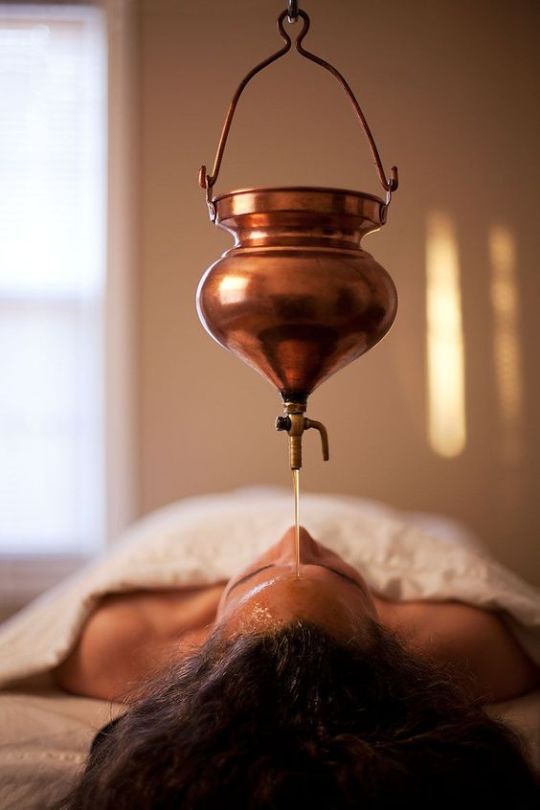
1/Sun Energy: Coconut Oil
Benefits: Harness vitality and strength with coconut oil. Its nourishing properties promote healthy skin, hair, and digestion, enhancing overall vitality and radiance.
How to Use: Incorporate coconut oil into daily cooking, skincare, and hair care routines for a boost of energy and vitality.
2/ Moon Energy: Almond Oil
Benefits: Embrace nurturing and soothing energy with almond oil. Its moisturizing qualities calm the mind and nourish the skin, promoting emotional well-being and tranquility.
How to Use: Massage almond oil onto the skin before bed or add a few drops to bathwater for a relaxing and rejuvenating experience.
3/ Mars Energy: Sesame Oil
Benefits: Channel fiery energy with sesame oil. Its warming properties stimulate circulation, boost immunity, and promote courage and strength.
How to Use: Use sesame oil for self-massage (abhyanga) or as a cooking oil to invigorate the body and mind.
4/ Mercury Energy: Jojoba Oil
Benefits: Embody communicative energy with jojoba oil. Its balancing properties support clear thinking, mental agility, and adaptability.
How to Use: Apply jojoba oil to the scalp and hair for hydration and balance, or use it as a carrier oil for essential oil blends to enhance focus and concentration.
5/ Jupiter Energy: Grapeseed Oil
Benefits: Align with expansive energy with grapeseed oil. Its light texture and antioxidant properties support growth, prosperity, and optimism.
How to Use: Use grapeseed oil as a moisturizer or massage oil to promote vitality and well-being, or add it to homemade skincare products for a radiant complexion.
6/ Venus Energy: Rosehip Seed Oil
Benefits: Embrace harmonious energy with rosehip seed oil. Its rejuvenating properties promote beauty, love, and creativity, nurturing inner and outer radiance.
How to Use: Apply rosehip seed oil to the face and body to reduce signs of aging and promote a glowing complexion, or use it as a natural alternative to moisturizers and serums.
7/ Saturn Energy: Castor Oil
Benefits: Embody disciplined energy with castor oil. Its detoxifying properties promote endurance, responsibility, and resilience.
How to Use: Use castor oil for oil pulling or as a massage oil to promote detoxification and grounding, or apply it to the scalp and hair for nourishment and strength.
8/ Rahu Energy: Neem Oil
Benefits: Harness transformative energy with neem oil. Its purifying properties help release toxins and negative patterns, promoting clarity and spiritual growth.
How to Use: Use neem oil as a natural remedy for acne or fungal infections, or incorporate it into skincare products for its antibacterial and antifungal properties.
9/ Ketu Energy: Frankincense Oil
Benefits: Embrace mystical energy with frankincense oil. Its grounding properties support meditation and introspection, promoting spiritual insight and inner peace.
How to Use: Diffuse frankincense oil during meditation or add it to skincare products for its rejuvenating and calming effects, promoting overall well-being and spiritual growth.
Incorporate these Ayurvedic oils into daily life to align with planetary energy, enhance well-being, and promote balance and harmony. 🪔🌿
119 notes
·
View notes
Text
Skin Care in Hindi Wellhealthorganic: Best Natural Tips and Remedies for Glowing Skin
Skin Care in Hindi Wellhealthorganic: Unlock the Secrets to Healthy, Glowing Skin
Introduction to Skin Care in Hindi Wellhealthorganic
If you're on the hunt for Skin Care in Hindi Wellhealthorganic, you're about to embark on a journey to discover natural and effective remedies for healthy, glowing skin. With the rise of organic skin care, many people are seeking ways to nurture their skin using traditional methods that have stood the test of time. The Wellhealthorganic approach focuses on using home-based, natural ingredients, making it a popular choice for those looking for safe and chemical-free skin care solutions. In this guide, we will introduce you to some of the best tips and remedies in Hindi, all backed by organic principles to help you achieve flawless skin.
What is Skin Care in Hindi Wellhealthorganic?
Skin Care in Hindi Wellhealthorganic is all about harnessing the power of nature to take care of your skin. The practice incorporates age-old remedies passed down through generations and uses ingredients like turmeric, aloe vera, neem, honey, and rose water. These ingredients are known for their medicinal properties and are gentle on the skin. Whether you have sensitive skin, oily skin, or dry skin, organic skin care methods offer a holistic solution that promotes clear, glowing skin without causing harm.
Top Skin Care Tips in Hindi from Wellhealthorganic
Here are some essential skin care tips in Hindi from Wellhealthorganic that you can easily follow at home:
Turmeric and Honey Face Mask for Acne A simple yet powerful treatment, turmeric, and honey work wonders for reducing acne and scars. Mix one tablespoon of turmeric powder with honey and apply it as a face mask. Leave it on for 15-20 minutes, and rinse off with warm water for clear, blemish-free skin.
Aloe Vera for Hydration Aloe vera gel is a versatile ingredient that soothes the skin, helps reduce inflammation, and keeps it hydrated. Simply apply fresh aloe vera gel directly to your skin and leave it on for 15-20 minutes before rinsing off. It’s an excellent remedy for dry and irritated skin.
Rose Water Toner for Skin Rejuvenation Rose water is not only refreshing but also a great natural toner. It helps balance the skin's pH, close pores, and hydrate the skin. You can use it as a spray or apply it with a cotton pad for a fresh, glowing look.
Neem for Acne-Free Skin Neem has antibacterial properties that can help fight acne and other skin infections. Make a paste by grinding fresh neem leaves with water and apply it to affected areas to keep your skin clear and healthy.
FAQ on Skin Care in Hindi Wellhealthorganic
Q1: How can I incorporate Skin Care in Hindi Wellhealthorganic into my daily routine? You can start by using natural products like turmeric, aloe vera, and rose water in your daily skincare regimen. Applying a turmeric mask once a week, using aloe vera gel every night, and spraying rose water throughout the day will help you maintain healthy skin.
Q2: What are the benefits of using Skin Care in Hindi Wellhealthorganic methods? These natural remedies are safe, free from chemicals, and help nourish the skin. Organic skin care treatments are ideal for preventing acne, reducing pigmentation, hydrating the skin, and improving overall skin texture.
Q3: Can I use Skin Care in Hindi Wellhealthorganic if I have sensitive skin? Yes! The beauty of organic skin care is that it's gentle and suitable for all skin types, including sensitive skin. Ingredients like aloe vera and rose water are especially soothing and calming for sensitive skin.
Q4: How soon will I see results from Skin Care in Hindi Wellhealthorganic? While results may vary, you should start seeing improvements in your skin’s texture and radiance within a few weeks. Consistency is key, so incorporate these natural remedies into your routine for the best results.
Conclusion: Embrace Natural Beauty with Skin Care in Hindi Wellhealthorganic
In conclusion, Skin Care in Hindi Wellhealthorganic is a holistic approach to achieving beautiful, radiant skin without relying on harsh chemicals. By incorporating simple, natural ingredients into your skincare routine, you not only improve the appearance of your skin but also protect it in the long run. Whether you're struggling with acne, dry skin, or pigmentation, the organic remedies mentioned above will help you address these concerns effectively.
Remember, the key to glowing skin is consistency, and using natural ingredients that nourish and rejuvenate your skin will give you the results you desire. Embrace the power of organic skin care, and watch your skin transform into a glowing, healthy version of itself!
source:-https://skincaresadvice.com/skin-care-in-hindi-wellhealthorganic/

#Skin Care in Hindi Wellhealthorganic#hydroxypropyl tetrahydropyrantriol uses#Mahanarayan oil Uses in Hindi#Coconut Oil for Skin Whitening#Best Makeup Women Over 50
2 notes
·
View notes
Text
A Natural Solution for Healthy Skin: My Positive Experience with Vestige Neem
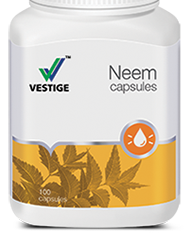
A Natural Solution for Healthy Skin: My Positive Experience with Vestige Neem
Having battled blemishes and uneven skin tone for years, I embarked on a quest to find natural, effective skincare solutions. After much research, I decided to try Vestige Neem, a product formulated with the powerful properties of the neem tree. Here's my honest review after incorporating Vestige Neem into my skincare routine.
First Impressions:
Vestige Neem comes in a simple yet appealing package. I found the tub easy to open and the neem paste itself has a pleasant, earthy aroma. The texture is thick and slightly grainy, but it spreads easily on the skin.
Combating Blemishes:
One of my primary concerns was reducing blemishes and preventing new breakouts. I was pleasantly surprised by the product's effectiveness. Within a few weeks of consistent use, I noticed a significant decrease in the number of blemishes on my face. Additionally, the existing blemishes seemed to heal faster and with less scarring. I attribute this to the neem's natural antibacterial and anti-inflammatory properties.
Promoting an Even Skin Tone:
Uneven skin tone was another bugbear of mine. Vestige Neem, with its natural blood purifying properties, seemed to address this issue as well. Over time, my skin tone appeared more even and radiant. I believe the neem's ability to remove dead skin cells and promote cell regeneration contributed to this positive change.
Gentle on the Skin:
Many over-the-counter blemish-fighting products can be harsh and drying on the skin. Thankfully, Vestige Neem was exceptionally gentle. It didn't cause any irritation or dryness, even on my sensitive skin. In fact, my skin felt softer and smoother after use. I credit the neem's inherent moisturising properties for this added benefit.
A Versatile Product:
Vestige Neem's versatility is another aspect I truly appreciate. Beyond using it as a face mask, I've also found it effective as a spot treatment for occasional breakouts. Additionally, a light application helps soothe minor cuts and scrapes. This multi-purposefulness makes it a valuable addition to my natural skincare regimen.
Overall Satisfaction:
I'm incredibly happy with the results I've achieved using Vestige Neem. It's a natural, effective product that has addressed several of my skin concerns. It's gentle enough for everyday use and offers a multitude of benefits. If you're looking for a natural way to achieve clear, radiant skin, I highly recommend giving Vestige Neem a try. Remember, consistency is key! The longer you use it, the better the results you'll see.
2 notes
·
View notes
Text
Embracing Nature's Bounty: Herbal Remedies for Eczema
In a world saturated with synthetic remedies, the allure of natural solutions is more compelling than ever. Eczema, a chronic inflammatory skin condition affecting millions worldwide, often calls for holistic approaches that minimize side effects while addressing the root causes. Amidst this quest for gentler yet effective treatments, herbal remedies have emerged as promising alternatives. Let's embark on a journey through nature's pharmacy to explore the realm of natural herb remedy for eczema.
Understanding Eczema
Before delving into herbal solutions, it's crucial to grasp the nature of eczema. Characterized by red, inflamed, and itchy skin, eczema manifests in various forms, including atopic dermatitis, contact dermatitis, and seborrheic dermatitis. While genetic predispositions and environmental triggers play significant roles, the immune system's dysfunction and impaired skin barrier function are central to its pathology.

Herbal Allies in Eczema Management
Herbs boast a rich history in traditional medicine, offering multifaceted benefits for skin health. From soothing inflammation to promoting tissue repair, these botanical wonders can complement conventional therapies or stand alone as holistic remedies. Here are some notable herbs renowned for their efficacy in eczema management:
Calendula (Calendula officinalis): Renowned for its anti-inflammatory and wound-healing properties, calendula is a cherished herb in herbal medicine. Its soothing effects make it a popular choice for alleviating eczema symptoms, including itching and redness. Calendula-infused creams or ointments can be applied topically to affected areas for relief.
Chamomile (Matricaria chamomilla): Chamomile's gentle yet potent anti-inflammatory and anti-itch properties render it a valuable ally in eczema management. Whether used in the form of tea for internal consumption or as a topical application, chamomile can help calm irritated skin and promote healing.
Licorice (Glycyrrhiza glabra): Known for its anti-inflammatory and antioxidant properties, licorice root extract holds promise in eczema treatment. Its active compound, glycyrrhizin, exhibits corticosteroid-like effects, making it effective in reducing itching and inflammation associated with eczema.
Aloe Vera (Aloe barbadensis): Aloe vera's cooling and moisturizing properties make it a popular choice for soothing eczema flare-ups. Its gel, derived from the succulent leaves, can hydrate dry skin, reduce inflammation, and accelerate wound healing, offering much-needed relief to eczema sufferers.
Burdock (Arctium lappa): Burdock root, revered for its detoxifying and anti-inflammatory properties, is increasingly recognized for its potential in managing eczema. Whether consumed internally as a tea or applied topically as a poultice, burdock can help purify the blood, alleviate inflammation, and promote clearer skin.
Neem (Azadirachta indica): Neem, often referred to as the "village pharmacy" in Ayurvedic medicine, possesses potent antibacterial, antifungal, and anti-inflammatory properties. Its oil or extract can be applied topically to eczema-affected areas to relieve itching, reduce inflammation, and prevent secondary infections.
Evening Primrose Oil (Oenothera biennis): Rich in gamma-linolenic acid (GLA), evening primrose oil is prized for its anti-inflammatory and moisturizing effects on the skin. When taken orally or applied topically, it can help improve skin barrier function, reduce inflammation, and alleviate eczema symptoms.
Incorporating Herbal Remedies into Your Eczema Care Routine
While herbal remedies offer promising benefits, it's essential to approach their use with caution and informed guidance. Here are some tips for incorporating herbal remedies into your eczema care routine:
Consult a healthcare professional: Before experimenting with herbal remedies, consult a qualified healthcare provider, especially if you're pregnant, nursing, or have underlying health conditions.
Patch test: Perform a patch test before using any herbal remedy to check for allergic reactions or sensitivities.
Choose quality products: Opt for reputable brands and sources when purchasing herbal remedies to ensure purity and potency.
Monitor effects: Keep track of how your skin responds to herbal remedies and adjust usage accordingly. Discontinue use if adverse reactions occur.
Practice holistic care: In addition to herbal remedies, adopt a holistic approach to eczema management, including proper skincare, stress management, dietary modifications, and lifestyle adjustments.
Conclusion
In the pursuit of eczema relief, the bountiful offerings of nature beckon with promising herbal remedies. From calendula's soothing embrace to neem's purifying touch, these botanical treasures offer holistic support for managing eczema symptoms and promoting skin health. By embracing the wisdom of herbal medicine alongside conventional therapies, eczema sufferers can embark on a journey toward greater comfort, vitality, and well-being.
2 notes
·
View notes
Text
Unveiling the Best: Top Skin Care Products in India
India, with its rich cultural heritage and diverse population, has long been a hub for natural remedies and skincare traditions. In recent years, the beauty industry in India has witnessed a surge in innovative skincare products, catering to a wide range of skin types and concerns. From Ayurvedic formulations to cutting-edge technology, let's explore some of the top skincare products making waves in India.
Himalaya Herbals Purifying Neem Face Wash Harnessing the power of Neem, a revered ingredient in Ayurveda known for its antibacterial properties, Himalaya Herbals Purifying Neem Face Wash is a favorite among Indian consumers. This gentle yet effective face wash deeply cleanses the skin, removing impurities and preventing acne breakouts. Enriched with Turmeric and Neem extracts, it leaves the skin feeling refreshed and rejuvenated.
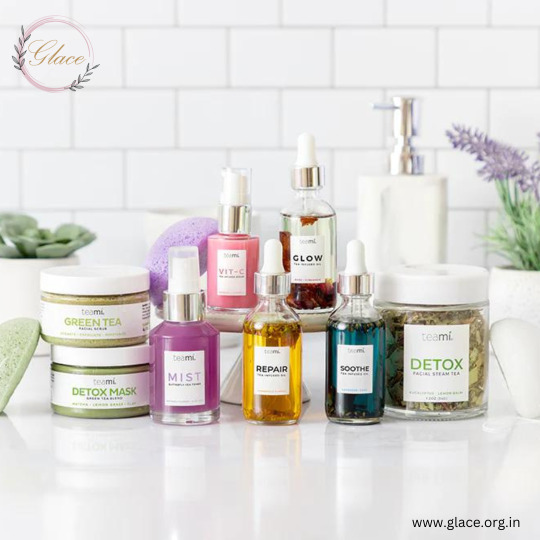
Lakmé Absolute Argan Oil Radiance Overnight Oil-in-Serum Lakmé, a household name in India, offers a luxurious skincare solution with its Absolute Argan Oil Radiance Overnight Oil-in-Serum. Infused with the goodness of Argan Oil, this serum deeply nourishes the skin overnight, revealing a radiant and youthful complexion in the morning. Lightweight and non-greasy, it absorbs quickly into the skin, making it suitable for all skin types.
Kama Ayurveda Kumkumadi Miraculous Beauty Ayurvedic Night Serum Drawing inspiration from ancient Ayurvedic texts, Kama Ayurveda presents the Kumkumadi Miraculous Beauty Ayurvedic Night Serum. Formulated with a blend of Saffron, Sandalwood, and other potent herbs, this serum works overnight to brighten the complexion, reduce dark spots, and improve skin texture. With regular use, it helps achieve a luminous and flawless complexion.
Biotique Bio Fruit Whitening & Depigmentation Face Pack Biotique, known for its commitment to Ayurvedic principles, offers the Bio Fruit Whitening & Depigmentation Face Pack, enriched with the goodness of fruits and botanical extracts. This revitalizing face pack helps lighten pigmentation, even out skin tone, and impart a healthy glow to the skin. Packed with natural ingredients like Papaya, Pineapple, Lemon, and Tomato, it provides multiple benefits in a single application.
WOW Skin Science Vitamin C Face Serum Harnessing the power of Vitamin C, WOW Skin Science Vitamin C Face Serum is a game-changer in the Indian skincare market. This lightweight serum helps brighten the complexion, fade dark spots, and protect the skin from environmental damage. With its antioxidant-rich formula, it promotes collagen production, resulting in firmer and more youthful-looking skin over time.
Conclusion India's skincare landscape is teeming with innovative products that blend traditional wisdom with modern science. From Ayurvedic formulations to cutting-edge serums, there is something for everyone in the diverse range of skincare offerings. By incorporating these top skincare products into your routine, you can achieve radiant, healthy skin that reflects India's timeless beauty traditions.
#best hair care products in india#top skin care products in india#best skin care products#daily skincare routine#best affordable skin care#skincare tips#skincare routine#skincare
3 notes
·
View notes
Text
Revitalize Your Skin
Revitalize Your Skin: The Art of Ayurvedic Abhyanga Oil Massage"
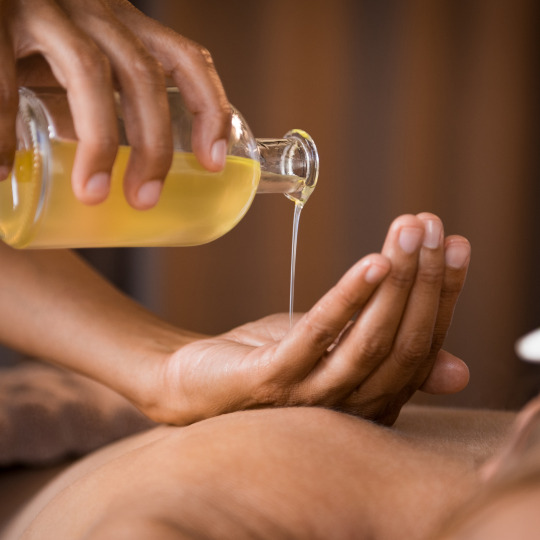
In the hustle and bustle of our daily lives, it's easy to overlook the importance of self-care and nurturing our skin. But what if I told you there's a centuries-old practice that not only rejuvenates your skin but also promotes overall wellness? Enter Ayurvedic Abhyanga oil massage—an ancient art that has stood the test of time, offering a holistic approach to skincare and well-being.
The Essence of Ayurveda:
Ayurveda, the ancient system of medicine originating in India, places a strong emphasis on maintaining balance within the body, mind, and spirit. Abhyanga, a key component of Ayurvedic self-care, involves the therapeutic application of warm, herb-infused oil to the body. This practice is not just a beauty ritual; it's a profound method to nourish and revitalize your skin while promoting inner harmony.
The Benefits:
Deep Hydration: Ayurvedic oils penetrate deep into the layers of the skin, providing intense hydration. This helps combat dryness, flakiness, and dullness.
Improved Circulation: The rhythmic and intentional massage strokes of Abhyanga stimulate blood flow, promoting better circulation. This, in turn, enhances the delivery of nutrients to skin cells and encourages detoxification.
Stress Reduction: The soothing nature of the massage calms the nervous system, reducing stress and promoting relaxation. As stress is a common culprit for skin issues, this can significantly contribute to a clearer complexion.
Lymphatic Support: Abhyanga aids in lymphatic drainage, helping to flush out toxins and reduce inflammation. This can be particularly beneficial for those dealing with puffiness and skin conditions related to inflammation.
How to Perform Ayurvedic Abhyanga Oil Massage:
Choose the Right Oil:
Sesame oil is a popular choice for its warming properties.
For a cooling effect, opt for coconut or sunflower oil.
Infuse the oil with herbs like lavender, chamomile, or neem for added benefits.
Prepare Your Space:
Find a quiet and comfortable space where you won't be disturbed.
Warm the room slightly to enhance the soothing experience.
Warm the Oil:
Place the oil in a warm water bath to achieve a comfortable temperature.
Begin with a Self-Prayer:
Take a moment to set an intention for your self-care practice.
Start at the Extremities:
Begin massaging your limbs, moving towards the heart in gentle, circular motions.
Focus on the Joints:
Pay extra attention to joints, such as the knees, elbows, and ankles, using circular motions.
Massage the Abdomen:
Use clockwise motions over the abdomen to support digestion.
Allow the Oil to Absorb:
Leave the oil on your skin for at least 15–20 minutes to allow absorption.
Follow with a Warm Shower:
Rinse off the excess oil with a warm shower, using a mild soap if needed.
Conclusion:
Incorporating Ayurvedic Abhyanga oil massage into your self-care routine isn't just about achieving radiant skin; it's a commitment to your overall well-being. Embrace this ancient practice as a ritual of self-love, and let the nourishing benefits ripple through your body, mind, and spirit. Your skin will thank you, and so will your inner balance.
#ayurveda#ayurvedic medicine#ayurvedic massage#restoration wellness#wellness#healthy lifestyle#health and wellness#ayurvedicmedicine#aromatherapy#skin care#skin care tips
2 notes
·
View notes
Text
🌿🌸 Unlocking the Ancient Secrets of Skincare: The Medicinal Origins of Cosmetics 🌸🌿
👉 Discover the captivating history of skincare that dates back 5,000 years to ancient Egypt! 👈

🌟 Did you know that the very first cosmetics were used by the Egyptians to achieve a pleasant scent and soft skin? Incense oils and crushed flowers were just the beginning of a remarkable journey that would merge beauty with medicine. 🌺💆♀️
👩🔬 Step into the world of the ancient Greeks, who not only introduced the term "cosmetics" but also combined their knowledge of herbs and oils to create beauty concoctions with medicinal effects. Their expertise paved the way for what we know as modern cosmetics today. 💡💄
🌱 But wait, there's more to cosmetics than just looking good! Discover the fascinating revelation that cosmetics in ancient times were designed not only to enhance beauty but also to promote skin and body health. 🌟💖
🔍 Let's take a closer look at some incredible examples. The iconic Egyptian eyeliner not only made eyes pop but also shielded them from harmful sunlight and germs! 🌞💫 And did you know that Indian kajal liner was crafted from antibacterial herbs like neem and triphala? 🍃🌿 Beauty with a healthful twist!
🌸 In Japan, a lipstick called Benizara was made from safflower and rumored to have amazing benefits – from preventing gynecological issues to boosting blood circulation! 🇯🇵💄
📚 The wisdom of ancient civilizations lives on through herbal remedies found in the "Ebers Papyrus" (Egypt), "Botany" (Greece), "Ayurveda" (India), "Shennong" (China), and "Ishinpo" (Japan). 🌏💚 Embrace this timeless knowledge that connects us to nature and our past.
🌿🌹 Organic cosmetics harness the incredible power of botanical extracts, using innovative techniques to preserve the perfect balance of nature's wonders. No wonder they have amazing antioxidant and age-preventing effects! 🌿🍃
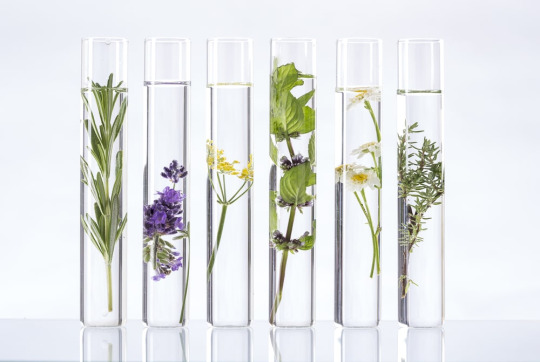
💧 Let's talk about some superstar plants used in organic cosmetics. Rosemary, known for revitalizing the skin and fighting aging, while Chamomile soothes, hydrates, and combats pesky spots and freckles. And lavender? It's a multitasker with its anti-inflammatory, antibacterial, and skin-revitalizing properties. 🌹🌼🌱
🌹 Gallica red roses, the beauty all-rounder, moisturize, firm, improve blood circulation, and enhance skin tone. And there's birch sap, an amazing ingredient that eliminates spots, dullness, fatigue, and stress while promoting skin renewal. 🌹💧
🌎 Organic cosmetics celebrate the complexity of nature �� containing countless beneficial components in perfect harmony. Unlike synthetic ingredients, which can have singular effects, these botanical wonders deliver a plethora of goodness! 🌺🌿
🍃 So let's appreciate the magic of nature, as even the most advanced modern science can't replicate a single leaf from a plant. 🍂🌱 Embrace the importance of organic cosmetics, rooted in ancient wisdom and abundant in natural plant ingredients. Together, let's achieve healthy, radiant skin the way nature intended! 🌿💖
📖 Dive into the full article: [Link to the Article] 📖
#SkincareHistory#AncientCosmetics#OrganicBeauty#NaturalWonders#AncientWisdom#BeautyAndHealth#NatureKnowsBest#HealthySkin#RadiantComplexion#OrganicCosmetics#DiscoverSkincare
2 notes
·
View notes
Text
pomegranate
Pomegranate
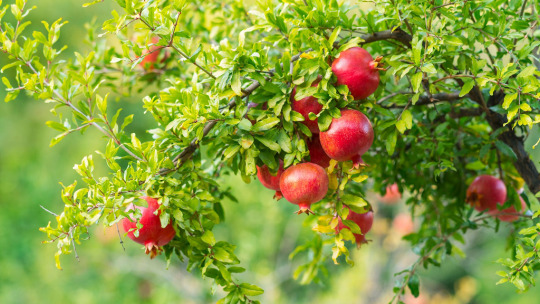
The pomegranate is famously known as the fruit of heaven belongs to the berry family. Pomegranate fruit is a delicious fruit and has juicy grains inside. Grow pomegranates as large, shrub or small trees.
Types

There are 1200 different varieties of pomegranate which have unique tastes and various colours. There are purple hearts, Eversweet, wonderful, kazake, red silk, texas pink.
Purple heart
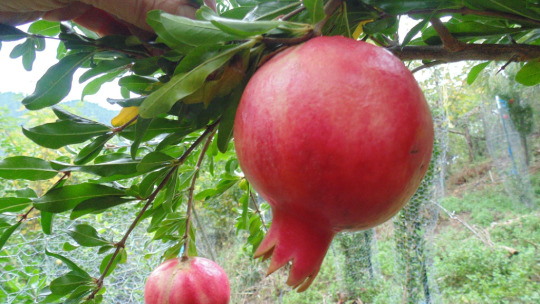
Purple heart varieties are large with dark red. Fruits begin to produce at about 3 years old. Pick fruit off a tree when it is mature. These pomegranate plants grow 12-30 feet tall and wide. Provide lots of health benefits. They are the best immune boosters and good healers.
Eversweet
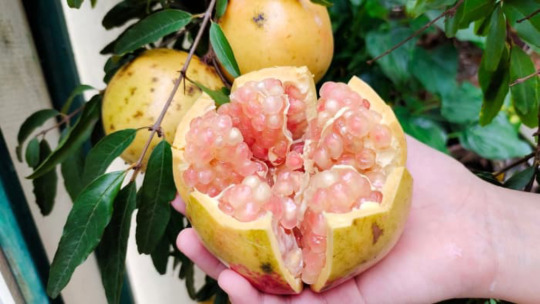
The color of the pomegranate is pinkish-pale red. Eversweet seeds are a little hard in texture and are highly nutritious containing vitamins A, C and E. Pomegranate trees are glossy, narrow leathery leaves which are lance-shaped. These varieties are self-pollinated. This is a national fruit of Iran.
Kazake
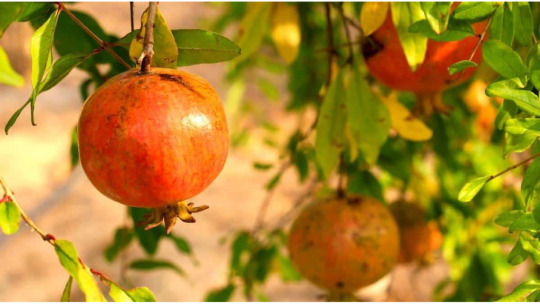
Kazake varieties produce medium to large size fruit. This is the most dwarfing species. This pomegranate plant is fast-growing with drought tolerant. This is a seeded fruit and it has a thick reddish outer covering. These flowers often fall off the branches rather than converting into fruit.
Red silk
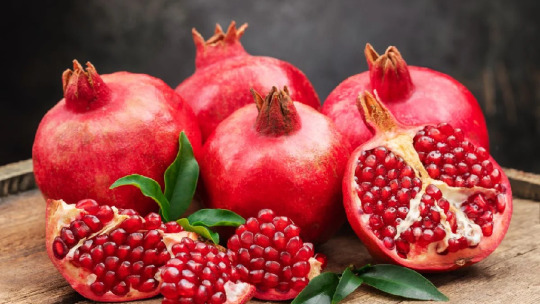
Red silk is the best pot-growing variety, which is a semi-dwarf growth habit. It has dark red flesh and red arils. Grows trees in hot and dry climatic conditions. Its contain fibre which keeps our digestive system healthy.
Texas pink

Texas pink pomegranate plant produces attractive blooming which converts pink fruits. This variety is a famous ornamental fruit plant. Texas pink is a self-fertile plant. It has large edible seeds.
Wonderful
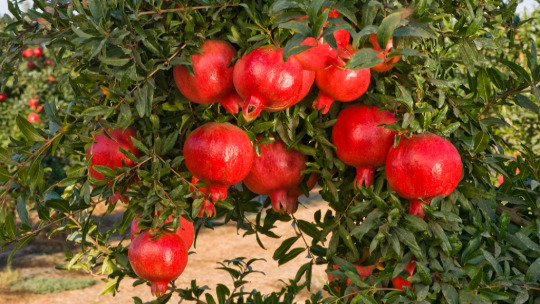
Wonderful pomegranate plant is the most common variety grown in the low desert of Arizona. Mix a teaspoon of natural honey in half a liter of water and spray directly on the flower with the help of a spray bottle. This will attract honey bees for pollination. This tip helps to increase the yield. This fruit is too sweet and highly beneficial.
Seed
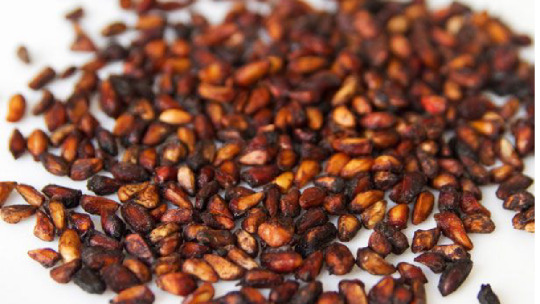
In this Punica granatum fruit plant seeds are also edible. It contains vitamins, minerals and antioxidants. In average one fruits can hold 1000 seeds. Seeds are covered with glowing red skin.
Soil

For better growth and development prefers to grow in well-drained loamy soil. Soil mix with 80% bone meal and 20% neem cake.
Water

For mature pomegranate tree, adequate irrigation especially during the dry periods is very important to improve growth, fruit set, yield and fruit size.
Sunlight

Select the location to keep the pomegranate plant with plenty of sunlight. In cooler climates, plant pome tree with western exposure. Requires 6 hours’ of direct sunlight.
Fertilizer
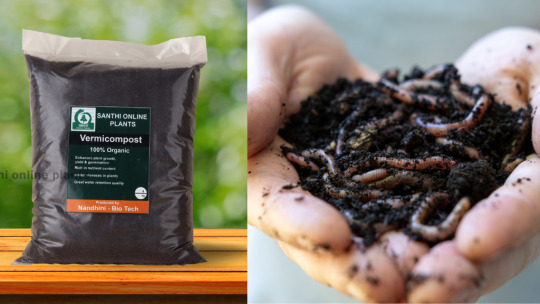
Good organic mulch and cow manure can improve plant growth and soil fertility. Application of vermicompost at monthly intervals.
Repotting
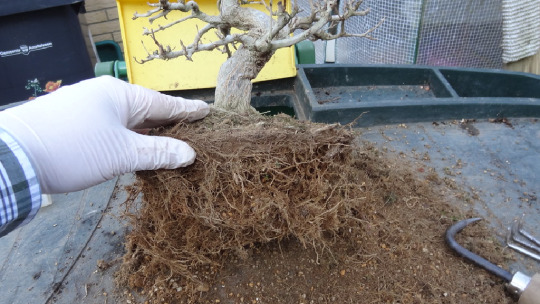
Repot the plant into a new pot when the root bound occurs. Normally repot the plant for two to three years.
Pruning
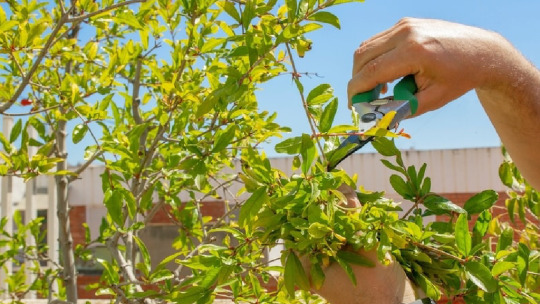
The best time for pome tree pruning is late winter, after harvesting the fruits. Branch pruning can increase fruit production. Pruning the roots will help to reduce root bound. Pruned the tree before repotting.
Benefits
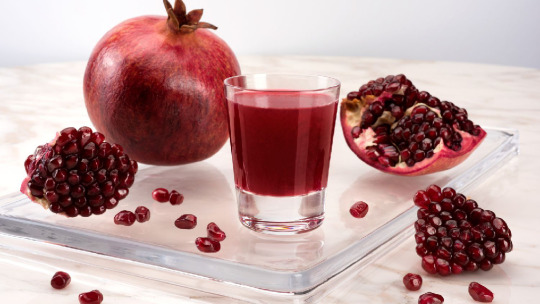
Daily consumption of pome gives us strength and energy
Its contain fibre which keeps our digestive system healthy.
Punica granatum helps to increase appetite.
Punica granatum is highly beneficial for pregnant women.
Reduces pain in joints and arthritis.
Keep your earth clean and green...!
#kazake#Kazake varieties produce medium to large size fruit. This is the most dwarfing species. This pomegranate plant is fast-growing with drought#Red silk#red silk#Red silk is the best pot-growing variety#which is a semi-dwarf growth habit. It has dark red flesh and red arils. Grows trees in hot and dry climatic conditions. Its contain fibre#Texas pink#texas pink#Texas pink pomegranate plant produces attractive blooming which converts pink fruits. This variety is a famous ornamental fruit plant. Texa#Wonderful#wonderful pomegranate plant#Wonderful pomegranate plant is the most common variety grown in the low desert of Arizona. Mix a teaspoon of natural honey in half a liter#Seed#seed pome#In this Punica granatum fruit plant seeds are also edible. It contains vitamins#minerals and antioxidants. In average one fruits can hold 1000 seeds. Seeds are covered with glowing red skin.#Soil#soil for pome#For better growth and development prefers to grow in well-drained loamy soil. Soil mix with 80% bone meal and 20% neem cake.#Water#watering for pome#For mature pomegranate tree#adequate irrigation especially during the dry periods is very important to improve growth#fruit set#yield and fruit size.#Sunlight#sunlight for pome fruit#Select the location to keep the pomegranate plant with plenty of sunlight. In cooler climates#plant pome tree with western exposure. Requires 6 hours’ of direct sunlight.#Fertilizer
1 note
·
View note
Text
Glowing Skin Naturally: The Ayurvedic Way to Skin Care
Having radiant, healthy skin is a dream for many, and Ayurveda offers a natural and effective way to achieve it. Ayurvedic skin care focuses on balancing the body’s doshas (Vata, Pitta, and Kapha) and using herbal remedies to nourish the skin from within. Unlike chemical-based treatments, Ayurveda provides long-lasting results by addressing the root causes of skin problems. Whether you're looking for a natural glow or relief from skin issues, ayurvedic skin treatment is the perfect solution.
Understanding Ayurvedic Skin Care
In Ayurveda, skin health depends on the balance of the three doshas: ✔ Vata (Dry Skin) – Needs deep hydration and nourishment. ✔ Pitta (Sensitive Skin) – Requires cooling and soothing treatments. ✔ Kapha (Oily Skin) – Benefits from detoxifying and purifying remedies.
Following a customized ayurvedic skin care routine helps maintain skin balance and prevents common issues like acne, dullness, and premature aging.
Best Ayurvedic Skin Treatments for a Natural Glow
1. Herbal Face Packs for Nourishment
Applying face masks made of turmeric, sandalwood, neem, and honey deeply cleanses and revitalizes the skin. These ingredients are known for their antibacterial and anti-inflammatory properties.
2. Abhyanga (Ayurvedic Oil Massage)
A gentle massage with herbal oils like coconut, almond, or sesame oil nourishes the skin and improves blood circulation. Regular ayurvedic skin treatment with oil therapy keeps the skin soft and youthful.
3. Natural Cleansing with Ubtan
Traditional Ayurvedic ubtan, made from gram flour, turmeric, and rose water, acts as a gentle exfoliator. It removes dead skin cells, giving the skin a fresh and bright appearance.
4. Hydration with Aloe Vera and Rose Water
Aloe vera gel and rose water act as natural moisturizers that soothe the skin, reduce inflammation, and provide a natural glow.
5. Detoxification with Panchakarma
A complete detox through Panchakarma therapy at an ayurvedic skin treatment center helps eliminate toxins from the body, resulting in clear and healthy skin. Consulting a skin specialist in Hyderabad can help determine the best detox plan for your skin type.
Daily Ayurvedic Skin Care Routine
🌿 Morning Rituals: ✔ Wash your face with herbal cleansers like neem or tulsi. ✔ Apply a natural toner like rose water. ✔ Use a light, herbal moisturizer suitable for your skin type.
🌿 Evening Rituals: ✔ Remove dirt and oil buildup with Ayurvedic ubtan. ✔ Apply a nourishing oil like kumkumadi tailam before bedtime.
🌿 Dietary Tips for Healthy Skin ✔ Drink plenty of warm water to flush out toxins. ✔ Include fresh fruits, leafy greens, and nuts in your diet. ✔ Avoid spicy, fried, and processed foods that cause skin imbalances.
Where to Find the Best Ayurvedic Skin Treatment?
For a personalized skin care routine and expert guidance, visiting a skin specialist in Hyderabad can be beneficial. Many Ayurvedic centers offer customized therapies to address specific skin concerns, ensuring a natural and long-term glow.
Conclusion
Achieving naturally glowing skin is possible with the right ayurvedic skin care routine. By following Ayurvedic principles, using herbal remedies, and consulting an experienced skin specialist in Hyderabad, you can enhance your skin’s health from the inside out. Ayurveda offers a holistic approach that not only improves the skin’s appearance but also promotes overall well-being.
Would you like to switch to an Ayurvedic skincare routine for lasting radiance?
0 notes
Text
A Beginner's Guide to Choosing the Right Ayurvedic Massage Oil

Introduction
Ayurvedic massage oils have been cherished for centuries for their profound healing and therapeutic properties. These oils are more than just lubricants for skin; they're deeply rooted in the ancient Indian system of medicine known as Ayurveda. Choosing the right Ayurvedic massage oil can significantly enhance your wellness journey, addressing specific health concerns, soothing the body, and rejuvenating the spirit. This guide will walk you through the essential aspects of selecting the best Ayurvedic massage oil tailored to your needs.
Understanding Ayurvedic Massage Oils
In Ayurveda, the balance of the three doshas—Vata, Pitta, and Kapha—is crucial for health and wellness. Ayurvedic massage oils are crafted with specific herbs and ingredients to balance these doshas. Each oil has unique properties that target different doshic imbalances, making it essential to identify your dominant dosha before selecting an oil.
Identifying Your Dosha
Vata Dosha: Associated with air and space, those with a dominant Vata dosha often experience dry skin, anxiety, and insomnia. They benefit from warm, nourishing oils that provide hydration.
Pitta Dosha: Governed by fire and water, Pitta types may struggle with inflammation, anger, and skin irritations. Cooling oils that soothe and calm are ideal.
Kapha Dosha: Linked to earth and water elements, Kapha individuals may face congestion, sluggishness, and oily skin. Light, invigorating oils help balance this dosha.
Choosing the Right Ayurvedic Massage Oil
1. Sesame Oil for Vata Dosha
Sesame oil is revered in Ayurveda for its warming and grounding properties, making it perfect for Vata types. It deeply hydrates and nourishes the skin, alleviating dryness and promoting a sense of calm.
2. Coconut Oil for Pitta Dosha
Coconut oil's cooling nature is ideal for balancing Pitta dosha. It soothes inflamed skin, reduces redness, and provides a refreshing sensation, making it excellent for sensitive skin.
3. Mustard Oil for Kapha Dosha
Mustard oil is invigorating and stimulating, making it suitable for Kapha individuals. Its warming effect helps improve circulation, break down congestion, and energize the body.
4. Herbal Infusions
Ayurvedic massage oils often contain herbal infusions like ashwagandha, turmeric, and neem, which enhance the oil's therapeutic effects. Consider oils infused with herbs that align with your health goals.
5. Scent and Aroma
The aroma of Ayurvedic massage oils plays a significant role in enhancing the massage experience. Opt for oils with scents that promote relaxation and well-being, such as lavender or sandalwood.
6. Purity and Quality
Choose oils that are organic and free from artificial additives. Quality is crucial in ensuring the oil's effectiveness and safety for your skin.
Benefits of Ayurvedic Massage Oil
Using the right Ayurvedic massage oil can offer numerous benefits:
Detoxification: Helps remove toxins from the body.
Relaxation: Eases stress and promotes a sense of calm.
Improved Circulation: Enhances blood flow and oxygen delivery to tissues.
Skin Nourishment: Rejuvenates and moisturizes the skin, leaving it soft and supple.
Enhanced Immunity: Regular massage with Ayurvedic oils can bolster the immune system.
How to Use Ayurvedic Massage Oil
Prepare the Oil: Warm the oil slightly before application for better absorption.
Create a Calm Environment: Ensure the room is quiet and comfortable.
Massage Techniques: Use long, fluid strokes for relaxation or vigorous movements to energize.
Frequency: Regular massages, ideally once a week, can maximize benefits.
Conclusion
Selecting the right Ayurvedic massage oil is a personal journey that involves understanding your body, your dosha, and your specific needs. By choosing the appropriate oil, you enhance not only your physical health but also your mental and emotional well-being. Shesha Ayurveda offers a range of expertly crafted Ayurvedic massage oils, designed to support your journey to balance and wellness. Embrace the wisdom of Ayurveda and transform your self-care routine with the perfect massage oil.
FAQs:
What is the best Ayurvedic massage oil for dry skin?
Sesame oil is highly recommended for dry skin due to its moisturizing properties, especially for Vata dosha types.
Can I use Ayurvedic massage oil on my face?
Yes, but choose a non-comedogenic oil like coconut oil to ensure it doesn't clog pores.
How often should I use Ayurvedic massage oil?
For optimal results, use the oil once a week, or more frequently if desired, depending on your skin needs and lifestyle.
Are Ayurvedic massage oils safe for sensitive skin?
Most Ayurvedic oils are gentle, but it's essential to do a patch test first or consult with a healthcare provider if you have sensitive skin.
What makes Shesha Ayurveda's Ayurvedic massage oils unique?
Shesha Ayurveda's oils are crafted using traditional Ayurvedic methods and high-quality, organic ingredients, ensuring purity and effectiveness.
0 notes